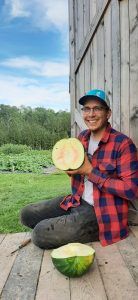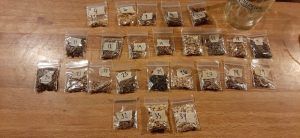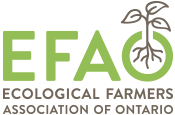Watermelons in Thunder Bay? A Landrace Breeding Project
By Sarah Larsen
It’s a hot August day, you are in the field with sweat dripping down your face — you are drenched in it, and you need a pick-me-up. If you farm in southern Ontario, you’ll make a beeline to the watermelon patch and break one open. Sweet and refreshing, watermelon is a staple summer treat.
However, for Evalisa McIllfaterick, a farmer in Thunder Bay, there’s a good chance there are no ripe fruit in July to give her that thirst-quenching watermelon sugar high.
In fact, over the last decade, Evalisa has tried many different varieties of watermelon and hasn’t been able to find a variety that is consistent with respect to ripening time and taste. Thinking back, she says “maybe out of 50 plants, I’d get three good melons.”
So when Evalisa listened to a podcast with Joseph Lofthouse on landrace seed breeding, she immediately thought it held a lot of potential as a method to develop shorter-season crops for growing in northern Ontario.
“After learning about it, I wanted to try landrace breeding and thought ‘what is the funnest thing we would want to grow up north really consistently?’ Brought back to those hot summer days, Evalisa thought of watermelon.

Aaron Halcovitch, a visitor from Morning Moon Farm, cracks open a melon to check ripeness. This one was not a winner!
Landrace breeding, explains Evalisa, involves planting a “bunch of different varieties of one crop together, so they all cross pollinate each other. You then save seed from the fruit that meets your needs, and continue to grow that seed out until you have a variety that has relatively stable criteria.”
A key to landrace breeding is to “keep the genetics diverse by having only a few specific criteria for selection,” says Evalisa. “And by keeping genetics diverse, the variety you develop is really adaptable.”
In her case, she wants watermelon that can “grow fruit in northern Ontario with good taste and texture,” which by default means watermelon that can also ripen enough in a short season.
To keep the genetics broad, she selected only on the basis of ripeness, taste and texture and ignored other traits like rind and flesh colour, fruit shape and size, and even yield in the selection process.
To help get this idea in the ground, Rebecca Ivanoff, EFAO’s Seed Program Manager, connected Evalisa with Manish Kushwaha of Gaia Organic Seeds, who had done a crossing of 23 types of watermelon for a breeding project that he was doing. She got seed from him, and started growing it out in 2020.
In 2022, Evalisa, Manish, and the farmers at Roots to Harvest in Thunder Bay decided to collaborate more formally in cooperation with EFAO’s Farmer-Led Research Program (FLRP).
Evalisa had conducted a spinach trial with the FLRP before and wanted to work with the FLRP because “it provides a framework to bring others into these exciting experiments, which is something I couldn’t do on my own.”
Through her experience with spinach, Evalisa knew she wanted the protocol to be “simple, because things go wrong!”
Specifically, they designed the protocol “to meet the needs of the breeding methods and the needs of market gardeners who might want to participate but without a lot of space to grow a potentially unmarketable crop,” says Evalisa.

The colour and shape of the melon seed is almost as variable as the melons themselves.
To do this, they decided that each farm would record “descriptive information about the fruit and save seed from the first 25 melons that met their criteria, and then track the total harvest from the patch,” describes Evalisa. “This means farmers could sell the rest of their melons after the first 25, just keeping track of yield.”
“We also decided to keep the 25 melon seeds separate — with general descriptions — so in years to come, if we want to go back to breed something more specific, we have seed to start with,” explains Evalisa.
In the following years, until they have varieties that are relatively stable, they will grow out seed that they saved from their farm, but not share across farms. In the end, each farm will produce its own landrace, and the farmers will be able to “see how different or similar their varieties look.”
And even though yield is not a major concern at the early stage, Evalisa explains that as they continually select tasty short season northern watermelon, they “inadvertently end up selecting for yield in that there will be more melons from high yielding plants contributing genetics to the pool.”
Can you picture it now? A watermelon patch full of beautifully different looking but delicious tasting and perfectly ripe fruit — in northern Ontario!
—
Sarah Larsen is EFAO’s Research & Small Grains Program Director and also supports soil health components of EFAO’s education programs. She holds a Ph.D. in Soil Microbial Ecology from Iowa State University, and along with her partner and their daughter, tends the land that they call Three Ridges Ecological Farm near Aylmer, Ontario.

